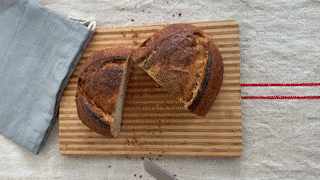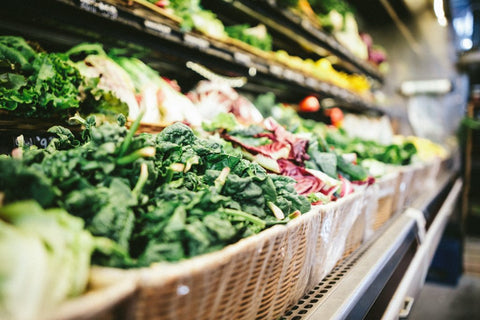Years ago, I was in a bakery pitching my linen bread bag to the owner/head baker. A woman in the adjacent line was listening intently. She interrupted our conversation. "Does it really work?" she asked. "I just throw out my stale bread."
I politely held in my gasp but answered her question in a ton of detail. {For more on the benefits of a linen bread bag, check out my first blog post: https://lot8.ca/blogs/the-yeast-of-it/whats-a-bread-bag-does-it-work. Needless to say, she bought a bread bag from me. You can buy one here: https://lot8.ca/products/oeko-bread-bag-for-bread-lovers?variant=42655634424048
But really, learning to use every slice of your loaf is prudent and minimizes food waste. A loaf of bread in Toronot is close to $8. Why not eat every part of it? Second, you could at least feed it to the birds rather than toss it in the green bin. But, better yet, feed yourself. Read on!

Food Waste in Canada
As many of you may know, global food waste is becoming a huge problem. According to a study by Second Harvest* here in Canada:
1. Nearly 60% of the food produced in Canada is tossed every year
2. 32% of that food waste and loss was avoidable
3. 4 million Canadians—including 1.4 million children—are food insecure
4. 56.5 million metric tonnes of CO2 equivalent emissions annually from food waste and loss in Canada

Small Hacks to Manage Food Waste
- Plan your meals and buy only what you need
- Research the best ways to store your food. For example, did you know that cilantro can last up to 2 weeks if you cut the stems and store them in a glass of water in the fridge?
- Learn to use food close to its expiration date rather than tossing it, such as freezing overripe bananas to use in banana bread
Saving Stale Bread

In some cultures, the stale nub at the end of a loaf is the coveted part of the bread. For me, that’s not the case. First, you can extend the life of your loaf by storing it properly.When you store it in paper, it becomes one large crouton. When you store it in plastic, the crust goes spongy and the bread moulds faster.
A linen bread bag allows your bread to breathe. As a result, the crust stays crispy and the interior stays moist. Cut your slices from the centre of the loaf. Put the two halves together and pop them back in the bag. Your bread will stay fresh up to 5 days. If in that time, you still haven’t finished the loaf (I admire your willpower!), take the remaining nubs out of the bag and continue to air dry them on a baking rack until they are fully dried out and crispy. If you have the strength, they would snap if you broke them in half. Now, you can store these in an airtight container for months.
Recipes for Stale Bread
And now, the fun part! Cooking with stale bread is so satisfying. It’s almost as if you got a meal for free. Plus, it’s delicious. Here are a few of my favs!
Homemade Bread Crumbs
for breading eggplant, pork chops, chicken fingers & more

The Way Grandma Made Them
•Cut your stale bread into equal sized chunks
• Spread out the chunks on a cooling rack and let dry at room temperature until they are crunchy and ‘snap’ when broken (this may take up to a week) • Bash with a rolling pin until desired crumb size is reached
• Store in a mason jar in the pantry for several weeks
Today with Mod Cons
• Cut your stale bread into equal sized chunks
• Preheat the oven to 250o F
• Place the stale cubes in a single layer on a baking sheet
• Bake for 10 minute. Check and stir
• If not sufficiently dry, continue baking and checking at 5 minute intervals • Remove from the oven and allow to cool slightly
• Transfer to the food processor and process until crumb stage is reached • Store in a sealed container in the fridge or freezer
Overnight Swiss French Toast
Stale bread? Make the world’s best French Toast! Traditional French Toast requires pan frying slices in stages, especially if you are feeding a crowd. It is time consuming and often, by the time the last piece is brown and crusty, the first is warm and soggy. My Swiss-German friend has shown me many great traditions from her childhood.

Yield: 4 servings
Ingredients:
6 slices dry bread (sourdough is delish)
2 beaten eggs
1/2 cup milk or non-dairy beverage
Method
-beat egg and milk in a small bowl
-break stale bread into pieces (no need to be fussy about the size). Put them in a bowl large enough to fit them and the beaten egg mixture -add egg mixture
-let sit overnight in the fridge
-in the morning, add a pat of butter to a fry pan. When melted, pour in your French Toast ‘mush’
-cook until the bottom is beginning to brown
-flip and brown the other side (this is best done by putting a large plate over the fry pan, flipping the French Toast onto the plate, adding butter to the pan and returning the French Toast to the pan, pale side down
-Cook until browned on both sides
-cut into slices and serve with fruit and maple syrup
So delicious!!!

Sage Butter & Garlic Breadcrumb Pasta

From Donna Hay Magazine
YIELD: 4 people
INGREDIENTS
-
400g pasta
-
1oz butter
-
1tbsp olive oil
-
3 cloves garlic, crushed
-
1 bunch sage leaves
-
1c fresh breadcrumbs
-
sea salt and cracked black pepper
-
1/2c finely grated parmesan cheese
PREPARATION
Cook pasta in large saucepan of salted boiling water until al dente. Heat a medium non-stick pan over high heat. Add the butter, oil and garlic and cook for 1 minute. Add the sage and cook for a further minute. Stir in the breadcrumbs, salt and pepper and cook for 1 minute until golden. Add to the pasta with the parmesan and toss to combine.
We'd love to hear your favourite recipes or bread saving story! Please share these in comments!

